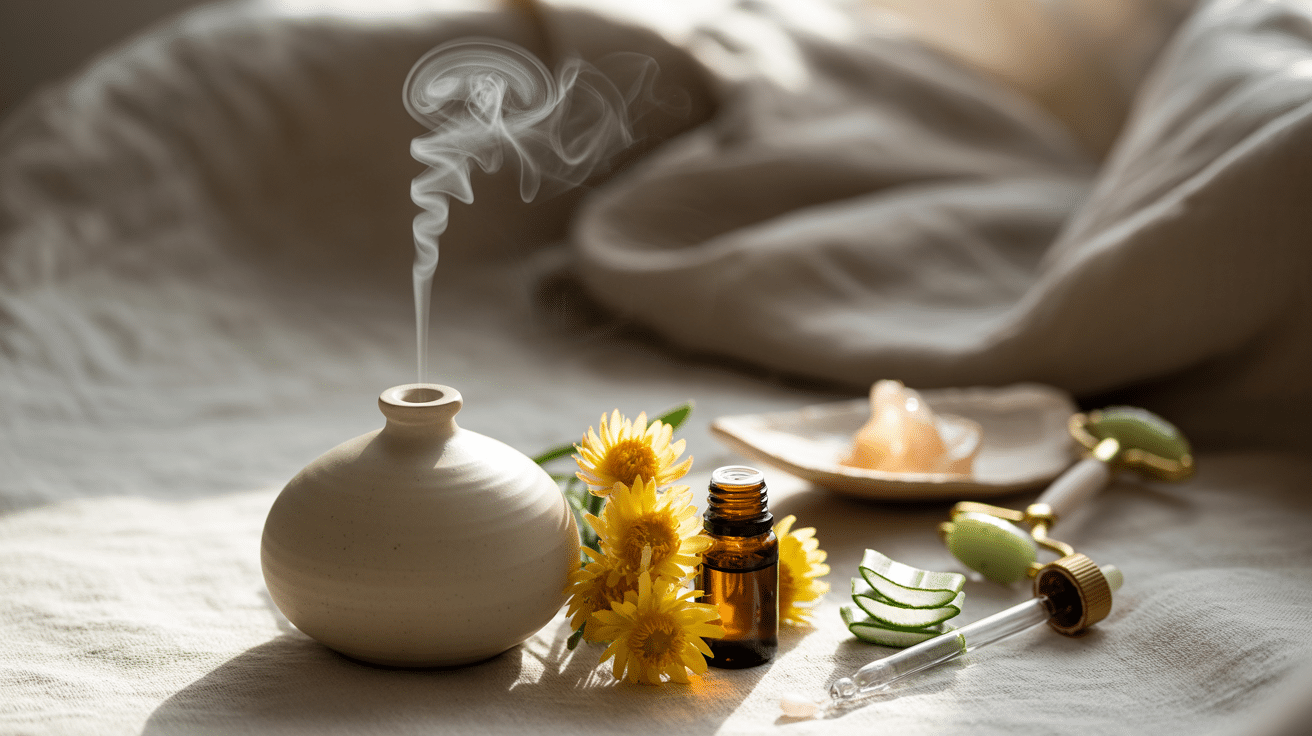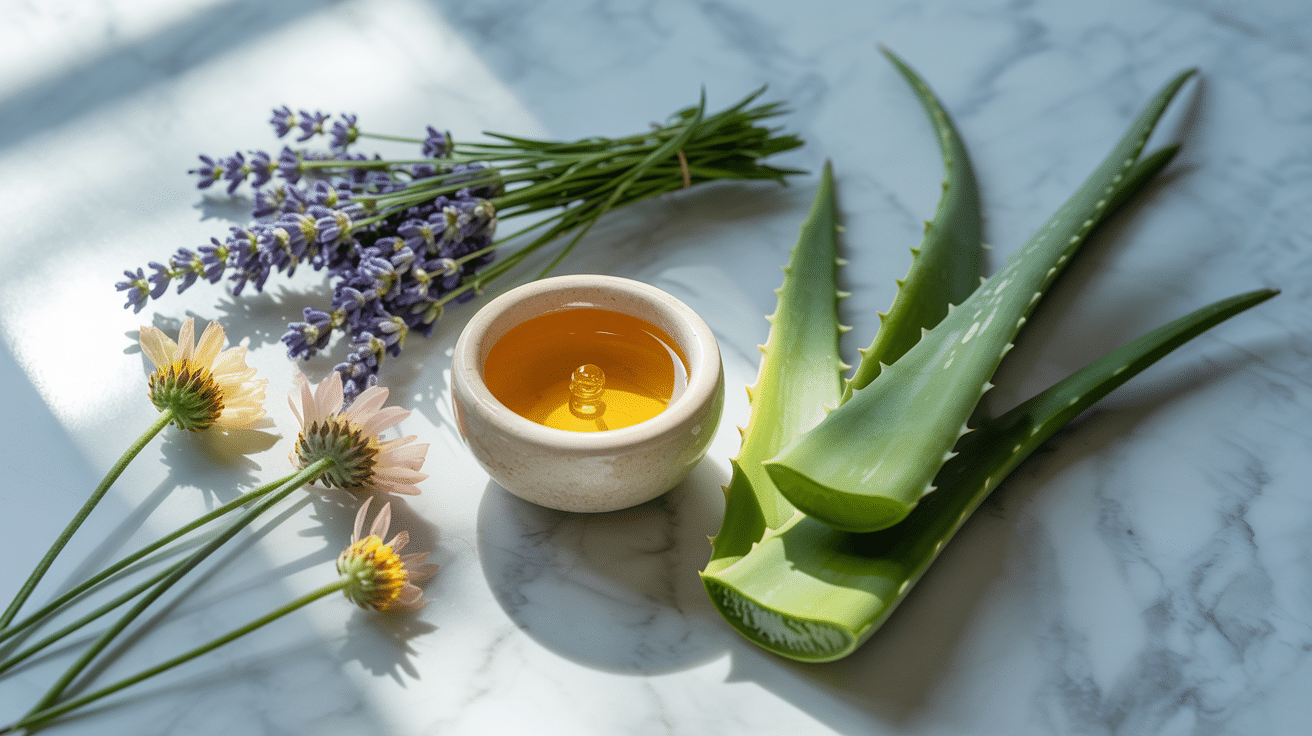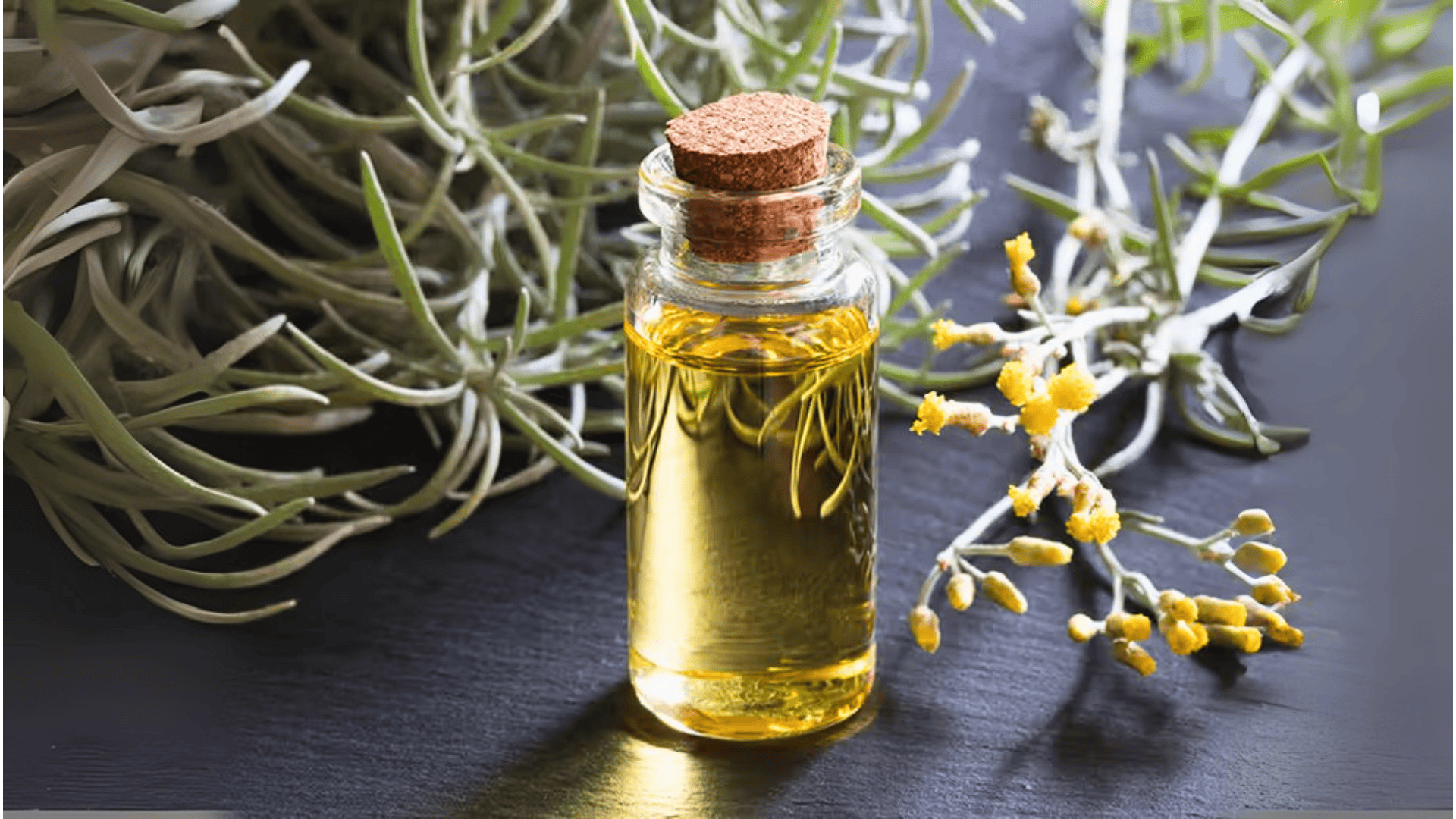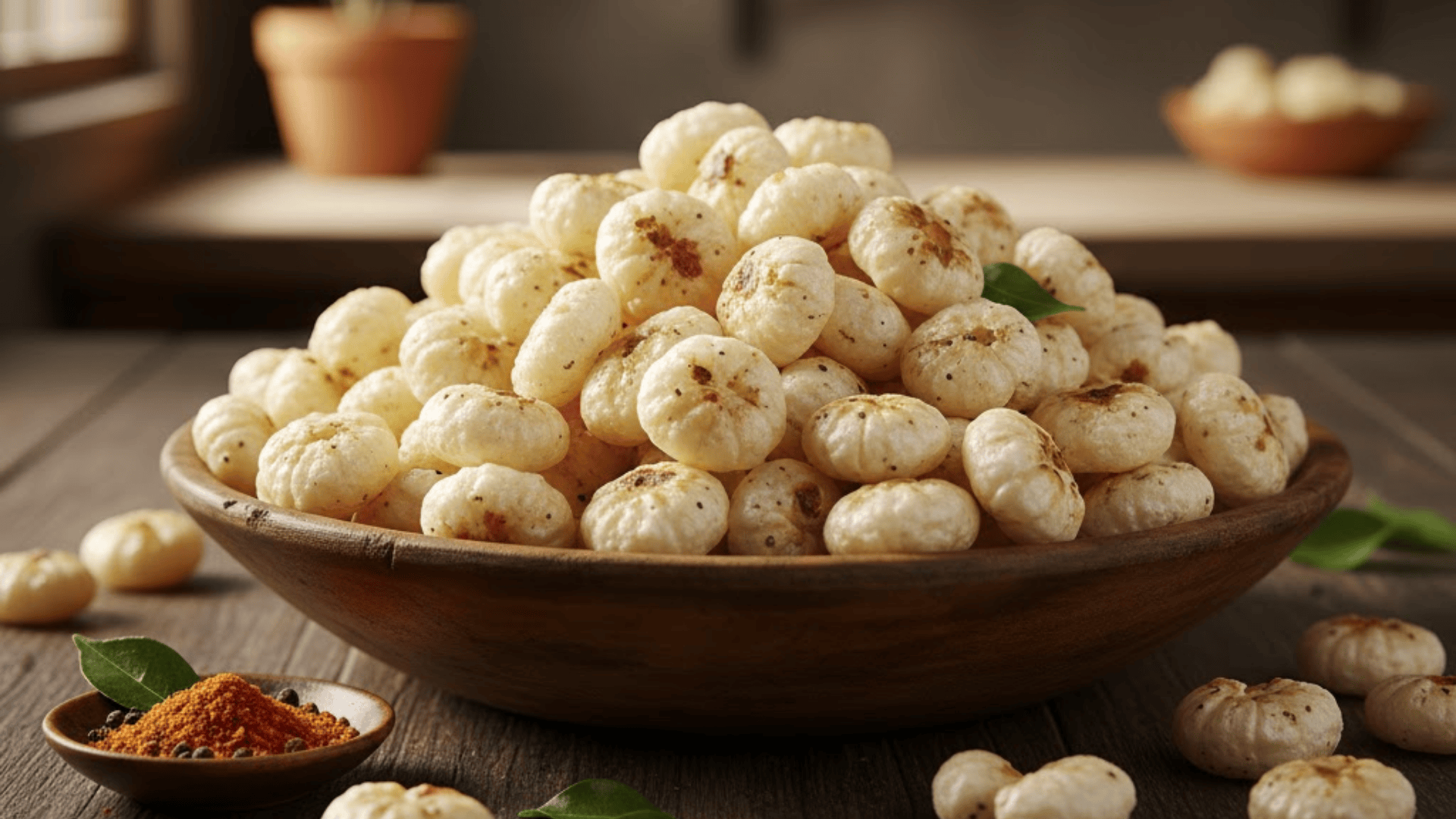If you’re wondering what helichrysum oil is good for, you’re in the right place.
I’ve been using essential oils for years, and this one quickly became a favorite. It’s not as well-known as lavender or tea tree, but it offers something special, especially for your skin.
Helichrysum oil has been used for generations to help with everything from minor scrapes to aging concerns.
In this post, I’ll walk you through the key benefits of helichrysum oil and why it deserves a spot in your routine.
You’ll also learn how to use it safely at home, no guesswork needed. If you’re new to essential oils or just curious, this guide is for you.
What is Helichrysum Essential Oil?
Helichrysum essential oil comes from the Helichrysum italicum plant, also known as “Immortelle” or “Everlasting.”
This hardy Mediterranean herb grows wild across southern Europe and has been valued for its medicinal properties for generations.
The oil is extracted through steam distillation of the plant’s flowers and leaves. This process captures the plant’s active compounds in their most concentrated form.
When you open a bottle of pure helichrysum oil, you’ll notice its warm, herbaceous scent with slightly sweet undertones. The aroma is earthy and grounding, making it popular in aromatherapy practices.
Traditional Mediterranean medicine has used this plant for wound healing, skin conditions, and respiratory support. Modern research is now backing up many of these traditional uses with scientific evidence.
Key Benefits of Helichrysum Essential Oil
Helichrysum oil contains powerful natural compounds like italidiones and flavonoids. These give the oil its impressive healing and protective properties.
1. Skin Health & Appearance
Your skin can benefit greatly from helichrysum oil’s regenerative properties. The oil helps reduce the appearance of wrinkles, dark spots, and fine lines by supporting natural skin cell renewal.
Many people use it to fade scars and stretch marks over time. The oil’s compounds help break down scar tissue while promoting healthy new skin growth.
If you deal with acne, rosacea, eczema, or psoriasis, helichrysum oil can provide gentle relief. Its anti-inflammatory properties calm irritated skin without causing further sensitivity.
The oil also supports your skin’s natural healing process after sunburns or minor injuries. It helps restore the skin barrier while reducing redness and discomfort.
2. Pain and Inflammation Relief
Helichrysum oil works as a natural pain reliever for muscle aches and joint discomfort. You can apply it topically to sore areas for targeted relief.
People with arthritis or sciatica often find it helpful for managing chronic pain. The oil’s anti-inflammatory compounds help reduce swelling in affected joints and tissues.
It’s particularly effective for bruise recovery. The oil helps break down blood clots under the skin while reducing pain and discoloration.
3. Antimicrobial and Antioxidant Properties
Research shows helichrysum oil can fight harmful bacteria like Staphylococcus aureus and fungi like Candida albicans. This makes it useful for treating minor skin infections naturally.
The oil’s antioxidant properties protect your skin from environmental damage. It helps neutralize free radicals that can cause premature aging and skin problems.
4. Emotional & Respiratory Support
In aromatherapy, helichrysum oil helps calm anxiety and mental tension. Its grounding scent promotes relaxation and emotional balance.
For respiratory support, the oil can help open airways and reduce congestion. People use it for sinus problems, coughs, and bronchitis symptoms.
How to Use Helichrysum Oil Effectively


Getting the most from helichrysum oil requires proper dilution and application techniques. Here’s how to use it safely and effectively.
1. Topical Application
Never apply helichrysum oil directly to your skin without diluting it first. Essential oils are highly concentrated and can cause irritation when used undiluted.
Mix your helichrysum oil with a carrier oil like jojoba, coconut, or rosehip oil. For facial use, stick to a 1-2% dilution (about 6-12 drops per ounce of carrier oil).
For body applications, you can use a slightly stronger 3-5% dilution (18-30 drops per ounce of carrier oil).
- For scars: Apply your diluted blend twice daily to clean skin. Massage gently and be patient – results typically show after 4-6 weeks of consistent use.
- For bruises: Dab the diluted oil gently around the bruised area three times daily. Avoid applying directly to broken skin.
- For acne: Use as a spot treatment on clean skin, or mix a few drops into your clay mask for added benefits.
Choosing the Right Carrier Oil by Skin Type
Your skin type determines which carrier oil works best with helichrysum.
- Oily or acne-prone skin: Choose grapeseed oil or jojoba oil. These absorb quickly without clogging pores.
- Dry or mature skin: Rosehip oil or argan oil provides extra nourishment and anti-aging benefits.
- Sensitive skin: Sweet almond oil or calendula-infused oil offers gentle, soothing properties.
2. Aromatherapy and Diffuser Use
Add 3-5 drops of helichrysum oil to your diffuser for emotional and respiratory support. Start with fewer drops and increase as needed.
Try these diffuser blend combinations:
- Helichrysum + lavender for bedtime relaxation
- Helichrysum + frankincense for meditation
- Helichrysum + bergamot for mood support
For direct inhalation, add 1-2 drops to a tissue or inhale from cupped hands. This method works well for quick emotional or respiratory relief.
Helichrysum Oil DIY Recipes and Everyday Uses


1. Bruise and Bump Roll-On
Purpose: For minor bruises, bumps, and soreness
Container: 10 ml roll-on bottle
Ingredients:
- 2 tablespoons fractionated coconut oil
- 8 drops helichrysum essential oil
- 4 drops of lavender essential oil
Directions: Mix ingredients and pour into the roll-on bottle. Apply directly to bruises or bumps as needed.
2. Skin-Calming Serum (Rosacea or Eczema)
Purpose: To calm red, inflamed, or sensitive skin
Container: 1 oz dark glass dropper bottle
Ingredients:
- 1 ounce rosehip seed oil
- 6 drops helichrysum essential oil
- 4 drops German chamomile essential oil
Directions: Store in a dark glass bottle. Gently apply to affected skin twice daily.
3. Sleep and Anxiety Diffuser Blend
Purpose: To promote relaxation and restful sleep
Use: Add to a diffuser with water according to diffuser guidelines
Ingredients:
- 3 drops helichrysum essential oil
- 4 drops of lavender essential oil
- 2 drops cedarwood essential oil
Directions: Diffuse 30 minutes before bed or during periods of stress.
4. After-Sun Skin Spray
Purpose: To soothe and cool sun-exposed skin
Container: 4 oz spray bottle
Ingredients:
- 4 ounces aloe vera gel
- 1 tablespoon witch hazel
- 10 drops of helichrysum essential oil
Directions: Combine all ingredients in a spray bottle. Shake well before each use. Spray generously onto affected areas.
Helichrysum Oil Safety Guidelines and Precautions
- Safe for most adults when used properly and diluted.
- Not for children under 6 years old.
- For children over 6, use very diluted amounts (0.5% or less) with adult supervision.
- Pregnant or breastfeeding? Talk to your healthcare provider before using.
- Keep away from pets, especially cats; many essential oils are toxic to animals.
- Possible skin sensitivity or allergic reactions may occur.
Patch testing instructions
- Mix one drop of helichrysum oil with one teaspoon of carrier oil
- Apply a small amount to your inner wrist
- Wait 24 hours and check for any redness, itching, or irritation
- If you have any reaction, don’t use the oil
If you take blood-thinning medications, consult your doctor before using helichrysum oil. The oil may increase bleeding risk.
How to Choose a Quality Helichrysum Oil
Look for oils specifically labeled as Helichrysum italicum. Other species like Helichrysum gymnocephalum have different properties and uses.
Choose organic when possible. Organic certification ensures the plants were grown without harmful pesticides or chemicals.
Check for purity indicators like GC/MS testing results. Reputable companies provide these lab reports showing the oil’s chemical composition.
Avoid oils that seem unusually cheap. Pure helichrysum oil is expensive because the plant yields very little oil. If the price seems too good to be true, it probably is.
Red flags for fake or diluted oils include:
- Unusually low prices
- No botanical name listed
- Missing company contact information
- Claims that sound too good to be true
- Plastic bottles (quality oils come in dark glass)
Buy from companies that specialize in essential oils and have good reputations. Read reviews from other customers to get honest feedback about oil quality.
Wrapping Up
Now that you know what helichrysum oil is good for, you can feel more confident about adding it to your routine.
From soothing your skin to offering support for aches and emotional tension, this oil brings a lot to the table, without being overwhelming.
I always suggest starting slow, using proper dilution, and choosing high-quality oil from a trusted source.
It doesn’t need to be complicated. Just take a little time to see how your body responds and build from there.
I hope this helped answer your questions and gave you useful steps to move forward. Feel free to check out more of my blog posts anytime you want, with simple tips or helpful ideas.











